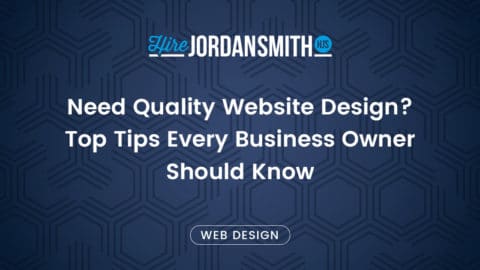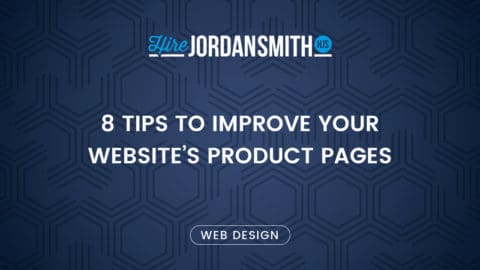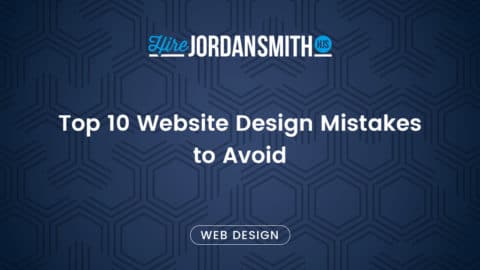In web design, as in life, positive first impressions are everything. Instantly engaging (and impressing) web visitors directly impacts brand trust. Moreover, first impressions determine the extent to which your prospects are willing to continue interacting with your website. This determines the amount of time you have to convince them to consider investing in your solutions.
And the thing is, research suggests that first impressions are formed in as little as 50ms. So, if you’re looking to grab your web visitors’ attention, know that you have to do it efficiently.
The good news is that UX research has identified how long web visitors need to zoom in on their key points of interest — 2.6 seconds. Moreover, we know what part of a website visitors spend more than 50% of their browsing time on — the first screenful, which is usually called the header or hero area. Lastly, studies suggest that people prioritize visual appeal when assessing a website, highlighting the importance of beautiful (and functional) website header design.
So, if you’re looking for design strategies that will allow you to instantly engage visitors, the following eight tips to help that are well worth considering for your next website upgrade.
Showcase Your Product at Its Best
When exploring design strategies that will help you engage website visitors, one of the essential things you must understand is how consumers choose what products to buy.
A 2018 survey set out to identify the website features that affected smartphone users’ purchase decision-making process. The results revealed that the most impactful element on product pages include product images (influencing 83% of consumers), followed closely by product descriptions, then social proof. So, if you’re looking to grab web visitors’ attention in a way that will inspire conversions, invest in stunning header imagery.
Of course, not just any images will do when trying to inspire purchase intent — especially not stock photos, which are widely used. Instead, do your best to showcase your products in a way that will grab your audience’s attention, help them perceive the value and benefits offered by your solution, and which will inspire them to click the “Buy” button.
For instance, one study from January 2014 discovered that consumers prefer product photos that show a large key object, use a warmer color scheme, and have a social presence. And if you look at the Clinique header, you’ll see it checks all the boxes, making it an exceptional example of a hero section meant to grab and retain web visitors’ attention.
But if you want to take things further, you can look at more research-backed ways to positively impact consumer attention. One scientific paper published in 2018 found that the most crucial attribute of product photos was textual information (the brand’s name, slogan, or description).
In other words, text in product photos (or on website headers) provides users with information about what the product does and what it can accomplish. Moreover, it adds context, leaving an overall positive impression and boosting consumers’ purchase intention. The GILI Sports website shows how the brand uses text to optimize its header to engage web visitors. Note how the most prominent element on the header image is the text, which calls potential customers’ attention to the fact that the Black Friday Sale includes a valuable free bundle with useful SUP accessories.
Generate an Emotional Response
Employing emotional marketing strategies is something many resources suggest when exploring ways to engage web visitors. But do you know the practical implications of successfully encouraging prospects to form emotional connections with your brand?
One research study found that when people are emotionally attached to a business, they are more likely to trust the brand and have a heightened interest in continuing a relationship with that organization. So, by employing visuals and text that make your audience feel specific emotions, you can effectively encourage engagement and conversions.
An excellent way to grab web visitors’ attention is to use header text that addresses consumer pain points.
You can do this in a positive context by highlighting the benefits of your products, as done on the Function of Beauty homepage, where web visitors are invited to “See the difference custom haircare can make.”
But you can also go rogue and achieve a similar effect by addressing negative emotions or consumer frustrations. Research has discovered that calling buyers’ attention to negative feelings can inspire them to act. So, doing something similar to Keeper, a brand that asks web visitors if they’ve forgotten their password, can help you successfully generate an emotional response, engage prospects, and inspire them to act.
Utilize Negative Space
In some cases, the best way to engage web visitors is to ensure they’re immediately attracted by your unique value proposition. And the most effective strategy to do that is to utilize sufficient negative space.
UX research shows that web users enjoy browsing websites that look simple and familiar, which explains why so many designers go for the minimalistic look these days. More importantly, using negative space as a prominent design element in your website header allows attention-grabbing (and conversion-driving) elements to stand out.
Specialist coffee retailer Kopi Luwak Direct manages to draw instant attention to its primary CTA (and showcase the natural beauty of its product’s origins) by limiting the header to only two elements.
Just look at how beautifully Muuto does it on its homepage, combining a four-word call to action with a background video that tells web visitors all they need to know about the brand’s offer. After a split second looking at the header, potential customers are well-aware that they’ve landed on an online presentation of a brand that connects design and functionality. Muuto makes it clear that it doesn’t have to rely on frills to prove that its solutions do exactly what they’re supposed to.
User-Friendly Search
Although it may not seem that impactful of an element when trying to engage web visitors, research shows that the search function on your website is one of the most crucial components to optimize when designing a high-performing homepage.
According to surveys, the average usage of onsite search is 5.75%, with visitors who use the feature converting 1.8x more than those who do not.
Of course, this isn’t the case on all websites. However, data does show that some websites drive more people to use the search function. And one of the reasons for this is complex website navigation or a large quantity of content.
So, as you explore ways to engage your visitors as soon as they land on your homepage (and encourage them to interact with the content on your site), explore ways the search function could allow you to do this.
For example, if you look at the MarketBeat homepage, you’ll notice that the search box takes center stage in the website header. But it’s not just that the feature is positioned well. More importantly, it’s designed with a user-oriented approach.
When web visitors click on the search box, they’re presented with the site’s suggestions of relevant content (without having to type anything). But, if they know what they’re looking for, prospects can enter a keyword. In that case, they’ll be shown companies, articles, and any other piece of info that matches their interest, making it super easy for them to get to the content they need on an otherwise complex and content-filled site.
So, does this mean that adding an interactive search box will fit your brand’s needs for engaging web visitors? Well, not necessarily.
In some cases, you’ll do better to enrich your site’s UX design with intuitive navigation and filters, like the ones below on the MATCHESFASHION website. But, if you think your audience could benefit from a search box, take the time to optimize it for UX, and rest assured that the effort will come with significant returns.
Ensure Your CTAs are Enticing
A powerful call to action is one of the crucial elements of a high-performing website header. There are two design rules you can use to design your CTA buttons if you want to guarantee your web visitors notice and click on them.
From a visual standpoint, the crucial factor for successfully designing CTAs is to ensure they stand out from the background.
To do this, you should primarily use color and contrast (a color wheel tool is always a lot of help during the design process). However, note that positioning and size will play a role in the button’s engagement potential.
If you check out the OpenSesame homepage, you’ll notice three CTA buttons in the first screenful, each positioned based on priority. The most prominent one invites users to book a demo, another encourages them to request a quote, and the third invites them to start a free trial. Each CTA uses the same shade of orange, seeing that it’s an attention-grabbing color that fits the brand’s visual identity. And the sizing changes based on the value of the particular outcome of a web visitor clicking on the element.
The second rule for designing CTAs that convert is to use action-packed language. Speak directly to your target audience, call their attention to the fact that you understand their pain points, and ensure they see that investing in your solution gives them the agency they need to solve their specific needs.
The design team behind the Calm app homepage does this spectacularly, creating a UI that asks web visitors what they need help with. Then, users are prompted to click one of the five CTA buttons, each resulting in a different outcome. Yes, this is a slightly complex way to create CTAs. Nonetheless, ensuring that prospects don’t waste any time getting to the outcome they need maximizes their satisfaction and, consequently, their chances of becoming the brand’s loyal customers.
Focus on Customer Benefits
One of the most common marketing mistakes brands make is that they try to sell their solutions based on impressive features.
Admittedly, highlighting features isn’t always the wrong choice — after all, expert users know what they require and don’t need to be told what benefits they could get from investing in a smartphone with a 4000mAh battery.
Nonetheless, when aiming to engage the average consumer, do your best to frame your offer based on the benefits you can deliver. The header section of your website is the perfect place to do this, as it’s the area people will look at first and the longest.
Use your site’s hero section to immediately describe the advantages your solution delivers and you’ll successfully attract web visitors’ interest. Moreover, if those benefits are what your web visitors are looking for, you’ll effectively inspire them to read about how your product works.
Thankbox shows us a really good example of communicating value over function. The opening line of their website header tells readers what THEY can do with the service and follows this up with a succinct, extremely relatable description of the pain point they solve for their customers.
Notice how there are hardly any mentions of product features. The customer’s needs are always taking center stage when it comes to describing what the product offers.
Showcase Social Proof
One of the prerequisites of engaging your audience is being authentic and presenting them with content they find valuable. This is true on all distribution and communication channels, especially on your website.
Now, if you look at the data about the types of content consumers consider authentic, you’ll discover that 60% of people find user-generated content to feel genuine. If you can include UGC in your website header design, you’ll automatically position your brand as authentic, relatable, and trustworthy.
Of course, the easiest way to include UGC on your website is to use social proof in its most basic format: user reviews.
Features like the Mannequin Mall Reviews flyout are a superb way to add advanced instances of social proof to your site. They’re attention-grabbing, allow for user interaction, and tell your target audience precisely what they need to hear (that you’re a business they can trust).
But that isn’t to say that you have to employ advanced header features to guarantee an engaging design.
In most cases, you can get equally impressive authenticity-building results by using the hero section to highlight your product’s average star rating. Alternatively, you could list your superstar clients — as done by Checkout below — or quote media mentions that could attract your audience’s attention and convince them to continue exploring your solutions.
Make Use of Video
Lastly, as you explore strategies to help you design a website header that instantly engages visitors, don’t hesitate to include videos in your hero section.
After all, knowing that 54% of people will watch a video all the way through, it’s easy to conclude that this format could prove to be the secret ingredient to next-level web visitor engagement rates.
If you’re a SaaS business, the video in your site’s header section should be an explainer. A survey conducted by Wyzowl in 2021 discovered that 96% of people watched explainers to learn about a product or service and, more importantly, 88% were convinced to make a purchase thanks to an explainer video.
This is why brands like Unroll.Me include videos in their hero sections, where they know they’ll be noticed and where the multimedia format stands a chance of convincing prospects to convert.
Of course, that’s not to say that eCommerce businesses can’t use video too. We’ve already mentioned one brand that uses product videos instead of photos. And if you check out the Bay Alarm Medical homepage, you’ll notice a similar instance of a business using the format to communicate what its product does in a way that’s super easy to understand and sure to resonate with its target audience.
Final Thoughts
As you should well know, web design is never a straightforward process. Engaging, impressing, and converting customers requires a stellar concept, even better execution, and a willingness to think outside the box.
Nonetheless, by following the eight design tips covered in this article, you can guarantee that your website header has the highest possible chance of attracting visitors’ attention. And, if you want to implement any of the strategies discussed here, you can rest assured that they’ll deliver results.
Of course, to ensure you’re getting the best possible outcomes, continue testing your site’s performance to identify additional opportunities to improve visual design and UX.




